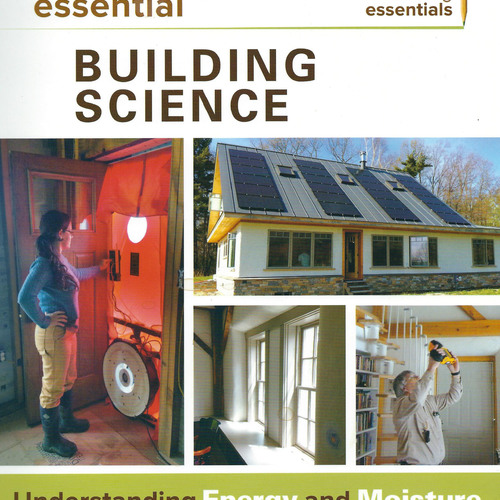
Image Credit: Jason Peacock
Image Credit: Jason Peacock Blackboard notes at the Building Science Discussion Group.
Image Credit: Jason Peacock Jason Peacock at the Building Science Discussion group. Floor plan for the Vocational School Rotary House project that was analyzed at the recent meeting of the Building Science Discussion Group.
Image Credit: Ben Rousseau and Jake Aube A section of the Vocational School Rotary House project.
Image Credit: Ben Rousseau and Jake Aube Another section of the Vocational School Rotary House project.
Image Credit: Ben Rousseau and Jake Aube
Each month in Portland, Maine, a group of building professionals gathers for an evening of serious Building Science banter. The topic is either focused on a specific aspect of building science or opens up a lively discussion of what a Pretty Good House (PGH) would do in our cold climate of Maine. (For more information on the Building Science Discussion Group in Maine, check out the links in the “Related Articles” box, below.)
There is usually no consensus and definitely no set of metrics etched in stone. Everyone seems to learn something and make good networking connections. Often, people leave with more questions than they came with, and a beer or two in their belly.
I’m Jason Peacock of Maine Green Building Supply, and I’ll try to recapture a recent evening as best I can.
Reports from the NESEA conference
The evening started with a round of introductions among the approximately 30 or 40 attendees. This was followed by a brief discussion regarding things seen at the Building Energy 13 conference in Boston the week prior.
Dan Kolbert, a builder and our usual moderator, mentioned that he’d listened to presentations on research on a variety of heating strategies for small spaces, and whether or not leaving the bedroom doors open or closed made a big difference. The recommendations focused on simplifying overall heating systems and delivery.
Liz Newman, an architect, mentioned that she’d been to a presentation about net zero buildings. The presentation focused on the big picture: “scaling up” for net zero cities, and how the Passivhaus standard will play a more prominent role in construction in the next ten years.
Steve Konstantino, our host and the owner of Maine Green Building Supply, mentioned that this year’s expo had more of a spotlight on building envelope products and less on solar energy than in past years. There seemed to be an abundance of triple-pane windows and products, like Siga tapes, to assist in achieving Passivhaus and net-zero standards.
High school students will be building a modular home
The next discussion topic was the Biddeford Regional Center of Technology’s Vocational School Rotary House Project 2013. (Images #3, 4, and 5, below, show some details and plans.)
Essentially, the school provides educational opportunities to high school students who build a house over a two-year period. They have two houses going at a time, with each house having two modules. The house is sold on the open market, so when they start building the house, they have no idea who the homeowner will be or where the home will end up.
Wayne Hapgood is the teacher. Wayne initially talked about the inherent constraints which determine the design and process:
- A modular home, with each module 12 feet wide
- Height must be less than 13’6”
- The house is built outdoors and must continuously stay weathertight
- Building envelope details needs to reflect current building “norms”
- Budget is a major factor
- The house is built by teenagers.
Wayne acknowledged that he was very brave to bring this project to the Building Science Discussion Group, knowing how knowledgeable and forward-thinking the group was regarding wall details and construction processes. He said that he was here with an open mind and was excited to learn.
He also mentioned that over the last twenty years, the more he learned about building science, the less he felt he knew.
He shared his current set of plans. He wanted advice on what to do better. He mentioned that working with 17-year-olds on a construction project is challenging, and that lessons needed to be hands-on and easy to understand. A majority of the students in his class have parents and family in the trades, so what they do in this class will definitely be discussed at the dinner table with dear old Dad.
He mentioned that he’d like to know more about air sealing.
Envelope and ventilation details
The proposed wall construction will be a 2×6 wall with fiberglass batts and 1 1/2 inch of exterior Thermax foam (because it’s cheaper and has a better R-value that alternatives). The wall has no vapor barrier so that it can dry to the interior. The home will have an ERV (energy recovery ventilator).
The ceiling has a 1/2-inch layer of rigid foam that is sealed at the perimeters with a small hand-held foam gun. The wall is R-31 and the ceiling R-51. (There will be 13 inches of cellulose above the 1/2 inch of foam).
The roof is vented at the eaves and the ridge. One additional note: the students don’t assemble the two modules together, the buyer does. That means that the quality of the final air sealing job will be uncertain.
Dan Kolbert mentioned that if the buyer is responsible for assembling the modules, then they should be presented with a checklist for air sealing properly.
Tim Spang of Spang Builders in Kennebunkport agreed that air sealing was very critical. Tim, along with his son Clayton and project manager Norm, are all graduates of Biddeford’s vocational school. He said that over the years he’s hired 30 to 40 students from this program. He mentioned that they are currently in the process of building a net-zero house, with the aim of achieving a blower-door test result of 1.0 ach50 or lower. He said that they learned a lot on their most recent house, but hadn’t really been keenly focusing on air sealing in the past. He stressed how important it would be for him when hiring new staff to know that they were learning what is cutting-edge for our future, not just the norm.
Diane Milliken of Horizon Maine brought up the fact that Keiser Homes, a modular builder in Maine, has done a really impressive job of air sealing their homes. She also mentioned that she’s worked with Westbrook Vocational School, and their double-stud wall project almost achieved the Passivhaus standard. She felt that the students were more interested because they felt they were on the cutting edge.
Jim Godbout of Godbout Heating and Plumbing offered to donate his blower-door equipment to make sure the air sealing was done effectively.
Choosing rigid foam
Liz Newman stressed that they should be using Advanced Framing techniques — an approach that allows builders to eliminate a portion of the wood normally used in framing. This saves money and allows for more insulation in the wall.
Chris Briley of BriBurn Architecture (formerly Green Design Studio) discussed the differences between XPS (with its questionable fire retardant chemicals) and Thermax (a brand of polyiso). He suggested considering two layers of rigid foam with taped, staggered seams. Since rigid foam almost eliminates drying to the outside, it’s important to facilitate drying to the interior.
Someone mentioned that recycled polyiso can be purchased from the Insulation Depot in Massachusetts. There was a brief discussion about dew-point calculations, and Wayne mentioned that he was concerned about condensation in the wall cavity. Someone mentioned a standard of 1:2 ratio of outside foam to inside cavity insulation, and then Chris Briley mentioned that the correct ratio was a 2:1 outside foam to inside cavity insulation. This would hint that more foam should be used on the outside to avoid having the possibility of condensation in the wall cavity. (For more information on this topic, see Calculating the Minimum Thickness of Rigid Foam Sheathing.)
Dan Kolbert recommended following the Airtight Drywall Approach. Wayne was very interested. I mentioned that it’s important to hang your drywall on the ceiling, mud, tape and paint, before you build your interior partitions.
There was a discussion about trying to get more insulation in the ceiling by field constructing a proper vented channel in-between the rafters instead of having the foam on the face of the rafters. This would enable thicker amounts of insulation near the eves. Several people were concerned that during transport the foam to air seal the ceiling may crack. Siga tape may be a better option.
HRVs versus ERVs
I mentioned that if they were planning on drying to the inside, they’d be better off with an HRV instead of an ERV, and that an HRV would do better mitigating moisture from the house. Their plan was to not have bathroom fans and have the ERV pull stale humid air from the bathrooms.
The next few minutes felt like a highly contested Senate debate with finger-pointing protests and spit-flying disagreements. You could say that not everyone agreed with me, and that for some reason there are still plenty of people, who will remain nameless, that still use ERVs in our cold climate.
Dan Kolbert (at this point acting like the Speaker of the House) said, “If I hear ERV one more time, I’m ending the discussion group.” Maybe the ERV vs. HRV debate will be our next BSDG topic. Let the rotten tomatoes fly!
How many blower door tests?
Liz Newman said that she recommends doing five blower-door tests during the construction process and that it is such a good educational tool to embed air sealing into their way of thinking.
There was a discussion about street orientation, and Wayne again mentioned that the design is not that fluid because they don’t know where the house is going when they start to build it.
One builder mentioned that he’d recommend spray foaming near rafter tails after all the ProperVents were installed to make sure that it was airtight. He thought that the spray foam would help stiffen up the whole module for moving.
Regarding the cavity insulation, the group was unanimous on getting the fiberglass batts out and using something else like blown-in cellulose. Charlie Huntington of I&S Insulation offered to lend the project his cellulose blower. Many people agreed that this would still be within the students’ abilities and that the house would perform a lot better.
Wayne mentioned that he’d built his own house just five years ago and that he wishes he knew then what he knows now. Dan Kolbert similarly said that he can’t bear to go to any house he’d build over six months ago, because things are progressing so rapidly now in high-performance building.
It was recommended that they still have Panasonic WhisperGreen fans in the bathrooms to help mitigate moisture in addition to the ERV or HRV. And with that it was a wrap.
MacBeth (and building science) doth murder sleep
Dan Kolbert ended the evening by saying, “Building Science is a good excuse to never sleep again.”
In summary, Wayne was very grateful for the time and advice shared by everyone. I think (maybe) that he left with some definitive answers to some of his questions. But I’ll also bet that he left with more questions than he arrived with – and therein lies the devil of building science.
Till next month…
Weekly Newsletter
Get building science and energy efficiency advice, plus special offers, in your inbox.














9 Comments
ERV vs HRV
I'm sorry I missed this one, nothing like a good ERV vs. HRV debate! It seems pretty logical that an HRV would do a better job at removing moisture--what was the argument against it?
HRV vs. ERV
Yes, this has been a good topic after the discussion group. The consensus is that "it depends" on a few factors to determine using an HRV or an ERV. The ERV will dehumidify, but it takes longer by diluting interior air with outside air that is less humid. One contractor said that he's only used ERVs and has never had a problem with mold.
If you have a large house with only one or two occupants then an ERV could be the better option. But in the event that the house were to be sold to a family with many kids and a couple heavy breathing dogs, then use an HRV.
I've heard of ERVs having issues with mosquitoes laying eggs in the standing water on the bottom of the unit, whereas a HRV would remove that water with a condensate drain line and not have this issue.
I have an HRV in my house and I figure I'll never have to worry about having high levels of humidity. I can always run it intermittently to not dry out too much.
First rule of Discussion Group
Is no one talks about HRV vs ERV. Almost as bad as toilet paper over or under.
Response to Dan Kolbert
Dan,
So now there are three taboo topics, not just two? Religion, politics, and balanced ventilation systems?
Anyway, I broke the taboo long ago: HRV or ERV?
Lively debate
Often when there is a "lively debate" it means that no one really knows the right answer. Not even Dr. Joe.
I would have expected the
I would have expected the generic HRV in my house to "dehumidify"
quite a bit more than it has over the winter, simply due to
bringing in cold outdoor air and warming it and thus pushing it
rightward on the psychrometric chart. With low occupancy and no
teenagers/plants and rare propensity for boiling pasta, it's been
averaging about 35% RH all winter here with a 66F setpoint. I
expected far lower, however. Typical dryness from winter air
exchange should be equivalent whether it comes through leakage
or comes through a ventilator, right? It's still exchange, and
still gets warmed over the same delta on the way in. I think an
ERV would have kept that RH even higher, which in zone 5 would
be just plain nuts.
_H*
I'm warning you
Don't make me come over there.
Response to Hobbit
Hobbit,
Here are the relevant factors:
- The tightness of your envelope
- Interior sources of moisture (including the basement -- the most important source in most homes)
- Your ventilation rate, which you did not mention.
And the winner is HRV
I'll go with an HRV 90% of the time. I know "it depends," but I'd rather not worry about high humidity in a tight house.
Log in or create an account to post a comment.
Sign up Log in